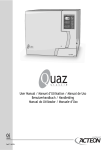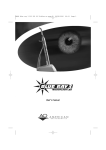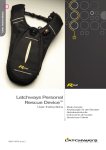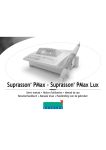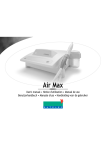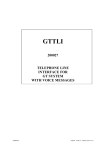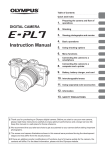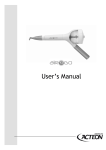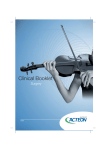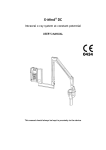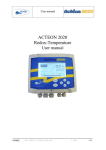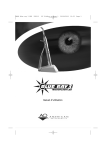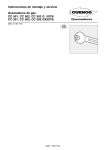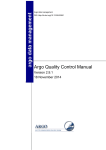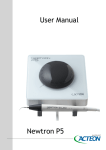Download User Manual - Autoclaves Service, Repairs and Validation
Transcript
User Manual Rev.02 – 12/2007 QUAZ Class B SATELEC – ACTEON GROUP PAGE 2 USER MANUAL Rev.02 – 12/2007 INDEX 3-6 1. INTRODUCTION 1.1. General Warnings 1.2. Technical characteristics 1.3. Warranty 1.4. Unpacking 1.5. Standard Accessories 3 4 4 5 5-6 2. GENERAL DESCRIPTION 2.1. Front view 2.2. Front view open door 2.3. Rear view 6 6 7 3. INSTALLATION/START UP 3.1. Installation 3.2. Electrical connection 3.3. Start up 3.4. Memory card connection 3.5. Installation filling/emptying the water 3.5.1. Filling with distilled water 3.5.2. Emptying waste water 7-8 8 8 9 9 9 10 4. CONTROL PANEL 4.1. Touch-screen 4.1.1. Main menu screen 4.1.2. Settings/user options screen 4.2. Setting time/date and programmed start 4.3. Personalising the autoclave 4.3.1. Selecting the unit of measurement 4.3.2. Selecting the language 4.3.3. Selecting the system to fill the tank with distilled water 4.3.4. Installing the printer and selecting the printing mode 4.3.5. Touch-screen configuration 4.3.6. Personalising the autoclave 4.3.6.1. Username 4.3.6.2. Installation date 4.3.6.3. Preheating 4.3.6.4. Latest cycles 4.3.6.5. Maintenance: Counter / Cycle reset 4.3.6.6. Cycles completed and time of operation 4.4. Test cycles (Vacuum and Bowie & Dick) 4.4.1. Vacuum Test 4.4.2. Bowie & Dick Test 10 11 11 12 12-13 13 14 14 15 15-16 16 16 17 17 17 18 18 18-19 19 19 5. NORMAL OPERATION 5.1. Available sterilisation programmes 5.2. Completing a cycle 5.3. Record / traceability 5.4. Warning signs 5.5. Error signs 19-20 20-21 21-22 22-23 23-24 6. MAINTENANCE 6.1. Regular maintenance 6.2. Preventive maintenance 25-26 27 6-7 7-10 10-19 19-24 25-27 27-28 7. TROUBLESHOOTING 8. SPARE PARTS / ACCESSORIES 8.1. Common spare parts 8.2. Optional spare parts 9. ANNEXES 9.1. Hygiene/sterilisation process 9.1.1. Cleaning the instruments 9.1.2. Preparing the sterilisation load 9.1.3. Sterilisation 9.1.4. Storing the sterile material 9.2. Distilled water in accordance with standard EN 13060 9.3. Opening the door without electricity 9.4. ‗QUAZ Viewer‘ User Manual 9.5. Electrical /electronic equipment waste (Directive 2002/96/EC) 9.6. Accompanying documents 28-29 28-29 29 29-35 29-30 29-30 30 30-31 31 31 31 32-33-34 35 35 Rev.02 – 12/2007 PAGE 3 SATELEC – ACTEON GROUP QUAZ Class B USER MANUAL 1. INTRODUCTION Note : Non contactual document. Copyright 2007 Satelec. All rights reserved. No information or part of this document may be reproduced or transmitted in any form without the prior permission of SATELEC. 1.1. GENERAL WARNINGS This manual explains the instructions for the following areas regarding the QUAZ autoclave: Installation Use Maintenance The purpose of this steam autoclave is to carry out ‗B‘ class sterilisation cycles (in accordance with standard EN 13060:2004) for all kinds of products: wrapped and non wrapped, solids, hollow loads type A and porous products. All the sterilisation cycles carried out in the QUAZ autoclave comply with the requirements for ‗B‘ class sterilisation, in accordance with standard EN 13060:2004, therefore any kind of load will be sterilised properly. The autoclave should be used as described in this manual and not following any other procedure. It should not be used in any other way or for any other product other than what is described in this manual. The user may compromise safety by using the appliance in a way that is not specified by the manufacturer. The user is responsible for a correct installation, good maintenance and a proper use of the appliance according to this manual. The manufacturer is not liable for any faults or damages on the autoclave due to misuse or faulty maintenance. Any repair or replacement of parts should be carried out by the authorised technical support, except for the procedures described in this manual that are part of regular maintenance carried out by the user. In both cases original replacement parts should always be used. Repair and maintenance should always be carried out with the equipment switched off and disconnected from the power supply. The autoclave should not be used in a place where there are gases or explosive vapours. Do not pour liquid on the appliance. Do not remove the identification or safety labels. Always use the instrument provided to remove the trays from inside, because after every sterilisation cycle certain parts of the autoclave will be hot, such as the trays, container, door and closing system. Before the sterilisation process, always check that the products placed inside tolerate the temperature and pressure of the sterilisation cycle that is going to be used (follow the recommendations of the products‘ manufacturer). Always use distilled or demineralised water that fulfils the requirements in Annex 9.2. If running water or water that does not fulfil these requirements is used, the life of the appliance will be shortened considerably and it will not be covered by the warranty. The safety valve is a protection element. It switches on in very extreme situations. If this happens, the autoclave may let off steam at the back, so the part where the safety valve is located should be away from people. The symbols that are used have the following meaning: Warning: see accompanying documents Warning: high temperature Earth connection Do not throw in domestic bins. Electrical /electronic equipment waste (See Annex 9.5). CE Marking in accordance with the European Directive 93/42/EEC on medical devices. QUAZ Class B SATELEC – ACTEON GROUP PAGE 4 USER MANUAL Rev.02 – 12/2007 1.2. TECHNICAL CHARACTERISTICS The technical characteristics of the QUAZ autoclave are the following: 1.3. WARRANTY The QUAZ autoclave has a 24-month or 2,000-cycle WARRANTY, only if the instructions described in this manual are followed carefully and periodic inspections are carried out. (See Chapter 6: ‗Maintenance‘.) Rev.02 – 12/2007 PAGE 5 SATELEC – ACTEON GROUP QUAZ Class B USER MANUAL 1.4. UNPACKING Upon receipt of the autoclave, check that the packaging and the equipment have no damages. If any kind of damage is detected, inform the courier and the supplier. The QUAZ autoclave and all the standard accessories and papers come in a reinforced box, measuring 570 mm wide x 670 mm long x 480 mm high. The packaging should be handled by two people, using the holes on the side of the box. To unpack the equipment: - Remove the staples from the top flaps and open them. - Remove the top and side protection. - Keep the two envelopes (papers and accessories) in a safe place - Lift the equipment up, with the help of another person, by the transport sling, with both hands as far apart as possible. - Remove it from the box and place it on the floor. - Remove the transport sling from the front legs (tilting the appliance the opposite way). - Remove the sling from the rear anchoring devices (by pulling down hard) until the anchoring devices come loose. Once the system is unpacked following the instructions, take it to its final location. Before moving the machine, always check that: The door is closed The water tanks are completely empty. It is disconnected from the power supply or from any other device (printer, conductivimeter, etc.) It is disconnected from the automatic water supply and the water drain. It should be moved by two people, putting their hands under the machine in the places specified in the picture (at the sides) and pulling upwards. 400 mm After arriving at the final location for the machine, lift the front part up slightly and lean the rear part on the wheels, and move hands away from this part. Then put the front part down and move hands away. Especially make sure that: The support surface has the required dimensions described in section 3.1 There are no elements in the way that may cause a fall when moving the machine. 1.5. STANDARD ACCESSORIES The autoclave comes with the following accessories: 1.2.3.4.5.6.7.8.9.- 5 perforated aluminium trays 280x180x20mm. 1 inox support for 5 trays/2 sterilisation vessels, size: 280x180x40 mm. 1 inox tray remover 1 tube with a union joint, to fill the tank with distilled water 1 tube with a union joint, to let out the waste water Instruction Manual 1 instrument to open the door in case of emergency 1 SD memory card with ‗QUAZ Viewer‘ software Accompanying documents (see Annex 9.6) QUAZ Class B SATELEC – ACTEON GROUP PAGE 6 USER MANUAL Rev.02 – 12/2007 3 1 2 5 7 4 9 8 6 Touch-screen 2. GENERAL DESCRIPTION 2.1 FRONT VIEW Handle to open the door Main switch (side) Hole for emergency opening Union joint, to fill Union joint, to Bacteriological the tank with let out the waste filter distilled water water Memory card slot + top led Front legs 2.2 FRONT VIEW OPEN DOOR Latch Hinge Support for trays and sterilisation vessels Sterilisation trays Door Silicone gasket Stainless steel Sterilisation chamber cover 17 litres QUAZ Class B USER MANUAL Rev.02 – 12/2007 PAGE 7 SATELEC – ACTEON GROUP 2.3 REAR VIEW Refrigeration grid Safety valve Conductivimeter Tank air inlet Connection for the automatic filling of distilled water RS 232 connector to external ‗QUAZ Printer‘ QUAZ label USB Connector Connection for the automatic emptying of waste water Union joint, to let out the distilled water Rear wheels Power cord 3. INSTALLATION / START UP 3.1. INSTALLATION After removing the autoclave from the packaging, it should be installed as follows: ● The autoclave should be placed on a flat levelled surface, with a width of at least 50 cm, leaving an empty space of 4 cm at the back of the machine. It can also be installed on a 45.5 cm surface, moving the front legs from position 1 to position 2. We recommend that the legs are kept in their original position (the most external one) to make the machine more stable. We recommend leaving an empty space of at least 3 cm at the top and the sides of the machine, so it has enough ventilation. ● Do not install the autoclave in a damp place. ● Do not place any objects on it. ● Keep it away from any sources of heat such as radiators or windows where there is direct sunlight. ● Install it in a well-ventilated place. ● Keep the machine away from places where there is a risk of explosion. ● Install the machine on a levelled surface. Pos. 2 Pos.1 IMPORTANT: ● Do not tip the machine when installing it, it may get damaged inside. Always keep it in vertical position. WARNING: ● The door will be blocked until the autoclave is connected to the power supply. ● The machine has a slight inclination at the back to facilitate the draining of the sterilisation vessel. In case the surface where it is installed is not levelled, this inclination should be maintained by adjusting the front legs. ● Always keep the door closed when moving the machine, do not use it as a support. QUAZ Class B SATELEC – ACTEON GROUP PAGE 8 USER MANUAL Rev.02 – 12/2007 ● Do not put pressure on the edge of the door while it is open (especially when the front legs are in the second position). 3.2. ELECTRICAL CONNECTION Check that the voltage of the power supply is 230 V ± 10%, 50 Hz, 10 A. Make sure that the electrical installation where the machine is connected is adequate for the voltage of the machine (max. 2,150 W). The autoclave should be connected to an electrical installation that has an earth connection and a safety switch that comply with the current legislation in every country. IMPORTANT: ● Unwind the power cord and do not place any objects on top. ● If a permanent installation is required for the automatic filling of distilled water and/or emptying of waste water, carry it out before connecting it to the power supply. 3.3. START UP Once the autoclave is installed, connect it to the power supply. To open the door, move the main switch to position ‗I‘, the touch-screen will come on and display the ‗QUAZ‘ welcome screen, then the ‗SERIAL NUMBER‘ screen, and finally, ‗OPEN DOOR‘. Press on the door icon on the touch-screen and the door will open. Remove the contents of the machine—5 sterilisation trays—and place them on the inox support that should be introduced inside the sterilisation chamber. 90º Machine software version Turn the support inside the vessel 90º to sterilise the 5 trays or 3 boxes (see optional accessories). Rev.02 – 12/2007 PAGE 9 SATELEC – ACTEON GROUP QUAZ Class B USER MANUAL 3.4. MEMORY CARD CONNECTION The memory card, which is supplied as a standard accessory, will store the information on the cycles that the autoclave performs. In order to see this information on the PC, install the ‗QUAZ Viewer‘ software (see annex 9.4). This software is available on the memory card (with the machine‘s User Manual). If the SD memory card is to be used for the traceability of the sterilisation cycles, before starting to use the autoclave insert the memory card in the slot with the label face down, pushing it until it stops. To remove the card press it lightly and pull it out. To see the cycles stored in the card use the ‗QUAZ Viewer‘. See Annex 9.4. 3.5 INSTALLATION FILLING/EMPTYING THE WATER The waste water tank can be emptied and the distilled water tank can be filled simultaneously and with the autoclave in any of the different operation stages (even while carrying out a cycle). 3.5.1. FILLING WITH DISTILLED WATER There are two systems to fill the autoclave, manual and automatic (see section 4.3.3). Manual filling - Filling with water from the front panel - Connect the tube with the union joint to fill the tank with distilled water - Press the icon to fill with water - It stops automatically when the tank is full. - The tank takes up to a maximum of 20 minutes to fill up with distilled water. If the tank is not full after 20 minutes, an Error 001 message will appear on the screen. Automatic filling (requires installation) - Filling from the back - Connect the tube for automatic filling (optional) – The maximum pressure should be below 2.5 bar. - Select the automatic filling option (see section 4.3.3) - The autoclave fills up with water at the end of each cycle - It stops automatically when the tank is full. - The tank takes up to a maximum of 20 minutes to fill up with distilled water. If the tank is not full after 20 minutes, an Error 001 message will appear on the screen. - The filling process can be activated/stopped by pressing the filling icon on the front panel. QUAZ Class B SATELEC – ACTEON GROUP PAGE 10 USER MANUAL Rev.02 – 12/2007 3.5.2. EMPTYING WASTE WATER There are two systems to empty the autoclave, manual and automatic (requires installation). It is not necessary to select the system because they are both gravity-operated. Manual emptying To empty the waste water tank, introduce the tube with a union joint to empty the waste water at the front of the autoclave, and it will empty by means of gravity. The waste water tank lasts at least 5 cycles. Automatic emptying (requires installation) Connect the tube to empty automatically (optional) at the back of the autoclave. Connect the other side of the tube to the nearest drain and the autoclave will empty by means of gravity without the user‘s intervention. Do not reuse the waste water, it can affect autoclave's life and operation, as well as the sterilisation parameters. 4. CONTROL PANEL 4.1. TOUCH-SCREEN The touch-screen is located on the front of the QUAZ autoclave. It is used to set and operate the machine. When the autoclave is connected to the power supply, press the main switch on the machine and the touch-screen will light up and display the ‗QUAZ‘ welcome screen. Then it will display the autoclave identification screen with the identification data (serial number) and the data set by the user (name of the clinic,...), (see section 4.3.6.1.). After a few seconds, the screen to open the door will be displayed if the door is closed, or the main menu if the door is open. The touch screen has an energy saving mode that will start 2 hours after the last operation. Backlighting will be switched off but all the others autoclave‘s components will remain activated. By touching the screen or closing the door, backlighting will be reactived. Information set by the user + QUAZ autoclave serial number and software version QUAZ Class B USER MANUAL Rev.02 – 12/2007 PAGE 11 SATELEC – ACTEON GROUP 4.1.1 MAIN MENU SCREEN Pressure inside the chamber Time Date Door warning (Door not detected) Temperature inside the chamber Door detected, press on this icon to close the door Selection of the ‗B‘ class cycle at 134ºC 4 minutes, (currently selected cycle) Press on this icon to open the door Selection of the ‗B‘ class cycle at 134ºC 18 minutes Warning to empty the waste water Selection of the ‗B‘ class cycle at 121ºC 15 minutes Warning low level of waste water in the tank + icon button to fill the tank with distilled water Go to settings/user options screen If the icon is flashing the waste water tank is almost full, it needs to be emptied in order to carry out a sterilisation cycle (see section 3.5) If the icon is flashing, the distilled water tank is almost empty; it needs to be filled up in order to carry out a sterilisation cycle (see section 3.5) 4.1.2 SETTINGS/USER OPTIONS SCREEN Go to the date/time settings and programmed start screen Go to test cycle screen (Vacuum and Bowie & Dick) Go to maintenance by a specialised engineer screen. Code required to access the maintenance screen Go to the autoclave personalisation screen Cycle counter Exit the screen QUAZ Class B SATELEC – ACTEON GROUP PAGE 12 USER MANUAL Rev.02 – 12/2007 4.2. SETTING DATE/TIME AND PROGRAMMED START SCREEN The date and time are always visible at the top of the touch-screen. They can be changed following these steps. On the settings/user options screen (see section 4.1) press Go to the screen to change the date and time. PROGRAMMED START This option enables the user to carry out a sterilisation cycle at the selected date and time, according to the following instructions. Once the date and time of the programmed cycle have been set, go to the cycle screen to select the sterilisation cycle desired. The user should make sure that the door is closed and that the machine has enough water for the cycle. If the door is not opened 45 minutes after cycle end, the anti-condensation mode will be activated. Select the date/time or programmed start with the cursors zeitverschobener Start). Exit the screen and return to the previous screen Press on this icon to go to the screen to change the selected option Change the selected number with the cursor. With the icon ‗OK‘, accept the selection and go to the next number. Once the date and time have been selected, press on this icon to return to the previous screen. All the information will be saved. 4.3. PERSONALISING THE AUTOCLAVE The language, pressure and temperature units, type of filling process, configuration of the touch-screen and printer, cycle information and autoclave settings can all be adjusted on the personalisation screen. Rev.02 – 12/2007 PAGE 13 SATELEC – ACTEON GROUP QUAZ Class B USER MANUAL 4.3.1 SELECTING THE UNIT OF MEASUREMENT The unit of measurement can be selected on the autoclave. The unit selected will appear on the top part of the touchscreen and in all the information on the sterilisation cycles that have been carried out. Press on the icon to select the unit required: - Bars/Degrees Celsius or - Pounds per square inch/Degrees Fahrenheit When the units have been selected, press on the icon to exit the screen and the previous screen will appear. The autoclave will display the selected units. QUAZ Class B SATELEC – ACTEON GROUP PAGE 14 USER MANUAL Rev.02 – 12/2007 4.3.2 SELECTING THE LANGUAGE On this screen the user can select the language that the autoclave will use for the touch-screen and the sterilisation cycle record. To select the language, press on the icon of the screen. Then select the language and press on the icon to exit the screen and the autoclave will switch to the selected language. 4.3.3 SELECTING THE SYSTEM TO FILL THE TANK WITH DISTILLED WATER There are two systems to fill the autoclave, manual and automatic (requires installation). Manual filling: Every time the autoclave displays a flashing icon, or whenever the user deems necessary, press on the icon ‗Fill with Distilled Water‘ and pour the distilled water at the front of the machine (see section 3.5). The machine can be filled at any time, regardless of the cycle stage it is carrying out at that moment. Automatic filling: When there is a permanent installation of a distilled water supply from an external tank at the rear/top of the machine (see section 3.5). In this case, every time a cycle finishes the autoclave will fill the internal tank with distilled water. When the external tank runs out of distilled water, ERROR 001 ‗Filling time exceeded‘ may appear if the tank is not refilled before the available time to fill it runs out. NOTE: The first time the tank is filled it should be done manually. Automatic filling Press the selected filling option Manual filling Press Exit Screen, the filling option will save and the previous screen will be displayed. WARNING: The tank is programmed to refill in less than 20 minutes. If it does not refill after this period of time, the screen will display the ‘FILLING TIME EXCEEDED’ warning. ERROR 001 Rev.02 – 12/2007 PAGE 15 SATELEC – ACTEON GROUP QUAZ Class B USER MANUAL 4.3.4 INSTALLING THE PRINTER AND SELECTING THE PRINTING MODE QUAZ Printer is the impact printer that is supplied as an optional accessory. It is connected at the back of the autoclave to an RS232 connection and the cable supplied with the printer. The printer also has to be connected to the power supply at 230 V. Press the main switch ‗ON‘ and the printer will connect. Then it should be loaded with paper (labels or continuous feed paper), depending on the option that has been selected for printing (see section 5.3). See the Printer User Manual for the specific printer instructions. QUAZ Printer Autoclave connection RS 232 The printing mode can be selected on the touch-screen (see section 5.3): Complete text of the cycle information. Summarised text to print on adhesive labels. In both cases the number of copies can be selected. Print the whole text Print labels WARNING: Before printing the copies make sure that the right kind of paper is loaded in the printer. Number of copies Exit screen and save the selected option If the number of cycles selected to be printed is 00 the printer will not make any copies. Select number of copies 4.3.5 TOUCH-SCREEN CONFIGURATION The level of brightness, contrast and sound signals can be configured on the touch-screen. QUAZ Class B SATELEC – ACTEON GROUP PAGE 16 USER MANUAL Rev.02 – 12/2007 Contrast Sound signal ‗BEEP‘ Brightness Press on the icon according to the option you would like to change Exit screen and save settings Select a value from 0 to 10 4.3.6 PERSONALISING THE AUTOCLAVE On this screen the user can personalise the autoclave with the autoclave identification data and the preheating, and have access to the latest memorised cycles, the counter and the maintenance RESET. 4.3.6.1 NUTZERNAME This option enables the user to see and retrieve the information on the last 50 cycles. Selected cycle Move the cursor to the required cycle Exit screen See the cycle information Print the cycle When the cycle is displayed it can be printed by pressing the printer icon. See the selected cycle Rev.02 – 12/2007 PAGE 17 SATELEC – ACTEON GROUP QUAZ Class B USER MANUAL 4.3.6.2 INSTALLATION DATE The QUAZ autoclave automatically sets the date of the first sterilisation cycle out of the factory as the date of installation. The user cannot modify this date; it is just for informational purposes. 4.3.6.3 PREHEATING To activate the ‗Preheating‘ operation, press on the icon. Once the ‗Preheating‘ operation is activated the sterilisation chamber will heat up until it reaches approximately 70ºC. The temperature signal on the touch-screen will start to flash. If a cycle is not started after 45 minutes the autoclave stops heating up. The ‗Preheating‘ option will stay on and it will heat the sterilisation vessel up again after each cycle or every time the autoclave is switched on. Press the icon to disable the ‗Preheating‘ operation IMPORTANT: The ‘Preheating' operation heats up the sterilisation chamber before starting the cycle so the cycle is carried out faster. Preheating on Preheating off Exit screen and save the selected option 4.3.6.4 LATEST CYCLES In this option the user has 40 characters available. The information will be saved in the autoclave identification screen (see section 4.1) and in the sterilisation record. Select alphanumeric character Select the option Confirm alphanumeric character Exit screen Exit screen and save the information See the selected option QUAZ Class B SATELEC – ACTEON GROUP PAGE 18 USER MANUAL Rev.02 – 12/2007 4.3.6.5 MAINTENANCE: COUNTER / CYCLE RESET This screen displays the cycles that are left to: Replace the bacteriological filter Change the silicone gasket on the door Require maintenance by a specialised engineer Check the state of the demineralising filter (optional accessory) if it is installed. The autoclave gives a warning 50 cycles before maintenance is required. This message will be repeated every 10 cycles, only once a day, until maintenance is carried out. Once the required maintenance has been carried out the counter will return to the original number (500 or 1,000) when it is selected with the cursor and the RESET icon is pressed. The autoclave saves the date of each reset after maintenance. 4.3.6.6 CYCLES COMPLETED AND TIME OF OPERATION On this screen the user can see the statistics of the cycles that have been completed (number of cycles completed of each type and average of cycles per day) as well as the time of operation in relation to the time the machine has been connected to the power supply. Select the option See the selected option Exit screen 4.4. TEST CYCLES (VACUUM AND BOWIE & DICK) On this screen the test cycles Vacuum and Bowie & Dick can be selected. Rev.02 – 12/2007 PAGE 19 SATELEC – ACTEON GROUP QUAZ Class B USER MANUAL 4.4.1. VACUUM TEST If the door is closed and the VACUUM TEST icon is pressed, the ‗VACUUM TEST‘ cycle will start automatically. IMPORTANT: - The VACUUM TEST performs a leak tightness test (to check that there are no microleaks) in the hydraulic circuit. - The VACUUM TEST should be carried out when the autoclave is at room temperature. - The VACUUM TEST should be carried out with the sterilisation chamber empty. - The values of the VACUUM TEST are expressed in absolute pressure values. Pressure (mbars) p0 p1 P2 P3 t0 t1 t2 t3 Time Room atmospheric pressure Lowest vacuum level Pressure after 300 s idle. Pressure after 600 s idle. Beginning of the test Time to reach the lowest vacuum level First vacuum test Second vacuum test The Vacuum test starts with the vacuum pump until it reaches 100 mbars. Then the vacuum pump switches off and checks the pressure P1. The autoclave remains in the position for 5 minutes (stabilisation of the vacuum value) until it checks the pressure value P2. The autoclave continues with the pressure system closed and it waits 10 minutes until it checks the pressure value P3. After the last 10 minutes the pressure is restored in the sterilisation chamber. The value of the loss equals ‗Pressure check 3‘ minus ‗Pressure check 2‘. The display shows if the result of the test is correct or incorrect and the loss that has been obtained. TEST CORRECT IF: P3 – P2 < 13 mbar 4.4.2. BOWIE & DICK TEST Place a standard test package in the sterilisation chamber to carry out the BOWIE & DICK test. This package has several sheets of sponge paper with a strip in the centre that changes colour according to the parameters that the machine reaches during the sterilisation process. When the test package is placed in the machine, close the door and press the ‗B & D‘ icon and the BOWIE & DICK test will start automatically. The cycle has the same parameters as the sterilisation cycles at 134ºC except for the sterilisation stage which lasts 3.5 minutes and the drying stage which lasts 4 minutes. IMPORTANT: ● The BOWIE & DICK test checks the penetration of steam in the sterilisation chamber. ● When the cycle has finished the QUAZ autoclave saves and displays on the screen if the cycle is correct or not, ANALYSING ONLY THE STERILISATION PARAMETERS THAT THE MACHINE HAS REACHED. The user should check the result of the cycle according to the colour of the strip, using the package manufacturer’s recommendations as a reference for the test. 5. OPERATION 5.1. AVAILABLE STERILISATION PROGRAMMES The QUAZ autoclave has three ‗B‘ class sterilisation cycles in accordance with standard EN 13060:2004 where all solid or porous products and hollow objects in a single or double packaging can be sterilised. NOTE: The length of the cycle and the amount of water used depend on the load and the initial temperature level of the autoclave. The following values have been calculated for the maximum load and with the autoclave at room temperature. QUAZ Class B SATELEC – ACTEON GROUP PAGE 20 USER MANUAL Rev.02 – 12/2007 STERILISATION CYCLES TYPE OF CYCLE Reference temperature of the cycle Pressure Length of the sterilisation stage Length of the drying stage Total length of the emptying – filling cycle Maximum use of distilled water TEST CYCLE ‘B’ CYCLE 134º Standard 135ºC 2,10 bar 4‘ 15‘ 32‘-48‘ 500 c.c. ‘B’ CYCLE 134º Prion 135ºC 2,10 bar 18‘ 15‘ 46‘-62‘ 640 c.c. ‘B’ CYCLE 121º Standard 122ºC 1,10 bar 15‘ 15‘ 40‘-52‘ 525 c.c. Bowie & Dick Helix Test 135ºC 2,10 bar 3‘ 30‖ 4‘ 28‘30‖ 300 c.c. YES YES YES YES YES 4.5/1.5 kg YES YES YES YES YES 4.5/1.5 kg YES YES YES YES YES 4.5/1.5 kg vacuum MATERIAL TO STERILISE Compact solid products Small porous objects Object with hollow objects type A Object with hollow objects type B No wrapping: single/double packaging Maximum load: Solid/Porous The ‗B‘ class cycles sterilise and dry any kind of object: Solid, porous, hollow objects type A, plastic, rubber, etc., with single or double packaging. However: Please follow the manufacturer’s recommendations For each programme, take into account the established maximum mass of the objects that are going to be sterilised, checked and approved by the manufacturer. PROFILE OF THE CYCLE AT 121ºC PROFILE OF THE CYCLE AT 134ºC Pressure (mbars) FRACTIONATED VACUUM STERILISATION 4‘ ó 18‘ VACUUM DRYING Pressure (mbars) FRACTIONATED VACUUM STERILISATION 15‘ VACUUM DRYING TIME TIME Optional vacuum Optional vacuum 5.2. COMPLETING A CYCLE Before performing a sterilisation cycle, see the recommendations given in section 9.1 of this manual. All sterilisation cycles can be accessed on the main menu screen. To start a sterilisation cycle, make sure that: The door is closed None of the tank level signs are flashing The temperature inside the chamber is under 105ºC The voltage of the power supply is above the minimum limit. Press on the icon to choose the cycle and the sterilisation cycle will begin. The stages of a cycle are displayed on the screen in two different ways: As data, showing the stages of the cycle, the temperature, pressure and start time of each stage. The stage that is in process will flash on the screen. As a cycle graph, pressure-time and temperature-time. 134ºC 4’ 134ºC 18’ 121ºC 15’ The QUAZ autoclave has sensors that detect the position of the door, making sure that it is closed at all times and preventing a sterilisation cycle from starting if it is not completely closed. Rev.02 – 12/2007 PAGE 21 SATELEC – ACTEON GROUP Cycle satisfactory or not QUAZ Class B USER MANUAL Stages of a cycle Cycle summary Voluntary interruption of the cycle (error 011 will appear) During the cycle this icon appears Accept the state of the cycle. This should be done to be able to open the door Go to cycle graph screen Temperature graph Pressure graph Go to data screen Fill with water At the end of each cycle the screen will display information on the temperature, pressure and time of each stage. The result of the sterilisation process is displayed and analysed, based on the pressure, temperature and length of the cycle, to check if the process complies with the strict requirements established by standard EN 13060:2004. If the process complies with these requirements, the QUAZ autoclave will display ‗cycle satisfactory‘ and an ‗OK‘ icon will appear. The user should press this icon to be able to open the door and remove the sterile materials from the machine. If the door is not opened 45 minutes after cycle end, the anticondensation mode will be activated. In case there is a problem that causes an error in any of the stages of the cycle, or if the process does not comply with the requirements established by standard EN 13060:2004 the autoclave will cancel the cycle and an error message will appear on the screen until the user presses reset and the machine will work again. The message ‗non satisfactory cycle‘ will also be displayed. In this case the materials inside the machine cannot be considered sterile. 5.3. RECORD/TRACEABILITY All QUAZ autoclaves have a memory card where all the information on the correct and incorrect cycles is stored. The memory card can be downloaded onto a PC to view and/or print the cycle information. There is also a printer, an optional accessory, which should be connected to the autoclave as described in section 4.3.4 and prints the data record of each cycle, as well as the summary of the information to put on labels. QUAZ Class B SATELEC – ACTEON GROUP Vacuum Test printing format PAGE 22 USER MANUAL Rev.02 – 12/2007 Cycle printing format Label printing format 5.4. WARNING SIGNS As well as the information that appears on the screen during cycles and the error messages, the QUAZ autoclave has a series of warning signs that appear on the screen so the user can act accordingly. Maintenance warnings Rev.02 – 12/2007 PAGE 23 SATELEC – ACTEON GROUP QUAZ Class B USER MANUAL Information warnings: The warning screens that are described below may appear when a cycle is NOT in process (when ‗STOP‘ appears, please contact the Technical Support Dept.). -Excessive pressure (on the idle screen). -Excessive temperature (on the idle screen). -Temperature system failure. -Pressure system failure. -Power supply failure. -Level detector failure. -Door malfunction. -Excessive temperature (when a cycle begins). -Low power supply voltage -Filling time exceeded. -Pressurised chamber (if the user tries to open the door with higher or lower pressure) -SD Card full 5.5. ERROR SIGNS The error signs may appear while the autoclave is performing any of the stages or during the constant analysis that the machine carries out of the parameters of the process. In all of these cases the autoclave will come to a full stop, there will be a series of short beeps and the error information will remain on the screen until the user presses reset. The autoclave does not unlock the door until the sterilisation chamber reaches an atmospheric pressure of +/- 60 Mbars. The error signs that the QUAZ autoclave displays are the following: No. ERROR 001 ERROR 002 (020,021,022, 023) ERROR 003 ERROR 004 (040,041,042) DESCRIPTION Filling time exceeded. The distilled water tank takes longer to fill up than the established time. Not enough heat. - One of the heating devices it not working properly. - The temperature has not been restored within the established time. - Sterilisation has not begun within the established time. Excessive pressure. The pressure inside the sterilisation chamber has exceeded the established limits for the stage in process. Low pressure. - The pressure has not been restored within the established time. - The machine has not reached the sterilisation pressure within the established time. - In the stages when the pressure increases, the pressure has not increased in the established way. ACTION Make sure that the union joints are connected properly and that there is enough supply of distilled water. Check that the distilled water filter is not obstructed. If the problem persists, please contact the Technical Support Dept. Make sure that the power supply is 230 + 10%. Allow the autoclave to cool down and repeat the cycle. If the problem persists, please contact the Technical Support Dept. Allow the autoclave to cool down and repeat the cycle. If the problem persists, please contact the Technical Support Dept. Make sure that the power supply is 230 + 10%. Allow the autoclave to cool down and repeat the cycle. If the problem persists, please contact the Technical Support Dept. QUAZ Class B SATELEC – ACTEON GROUP No. DESCRIPTION PAGE 24 USER MANUAL Rev.02 – 12/2007 ACTION ERROR 005 (050,051,052 053,054) Excessive temperature. - The temperature inside the sterilisation chamber has exceeded the established limits for temperature in the stage in process. - The temperature inside has exceeded the established limit. - The temperature of the heating devices has exceeded the established limit. Allow the autoclave to cool down and repeat the cycle. If the problem persists, please contact the Technical Support Dept. ERROR 006 (060,061,062, 063,064,065) Vacuum pump failure. During the Vacuum Test the vacuum pump has not reached the established vacuum values, the fractionated vacuum or drying, within the established time. Make sure that there is nothing obstructing the ventilation system. Make sure that the fans are in good working order Allow the autoclave to cool down and repeat the cycle. If the problem persists, please contact the Technical Support Dept. ERROR 007 (070,071,072, 073,074,075, 076,077,078) Faulty sterilisation. During the sterilisation stage the temperature or pressure values are different to the established values and to the values accepted by standard EN 13060:2004. Allow the autoclave to cool down and repeat the cycle. If the problem persists, please contact the Technical Support Dept. ERROR 008 (080,081,082) Faulty decompression. If the machine does not reach the values of decompression within the established time. Allow the autoclave to cool down and repeat the cycle. If the problem persists, please contact the Technical Support Dept. ERROR 009 Faulty ventilation. If the pressure has not been restored during the ventilation stage within the established time. Check the state of the bacteriological filter. If the problem persists, please contact the Technical Support Dept. ERROR 010 Power failure. If there is a power cut during a cycle, because the supply fails or because the machine‘s own safety devices fail. Check that there is a constant power supply. Allow the autoclave to cool down and repeat the cycle. If the problem persists, please contact the Technical Support Dept. ERROR 011 ERROR 012 (120, 121, 122 123,124) ERROR 013 ERROR 014 ERROR 015 (150,151,152) ERROR 016 (160) Interrupted cycle. The user cancels the sterilisation cycle deliberately Temperature system failure. - When the system detects that the cable of a temperature sensor is damaged. - When the system detects a malfunction of the room temperature sensor inside. Pressure system failure. When the system detects that the cable of the pressure sensor is damaged. Lack of leak tightness. When the loss values are higher than the values required by standard EN 13060:2004. (10% of P0 - P1 for the stabilisation time or 10% P0 - P2 for the measurement time.) Power supply failure. There is not enough voltage in the internal power supply of the machine Door malfunction. The electrical security locks on the door detect an incorrect position --- Please contact the Technical Support Dept. Please contact the Technical Support Dept. Check the state of the silicone gasket and make sure the door is closed properly. Repeat the cycle. If the problem persists, please contact the Technical Support Dept. Check that there is a constant power supply. If the problem persists, please contact the Technical Support Dept. Follow the instructions on the screen. Turn the emergency key in any direction until it stops (max. 20 times) If the problem persists, please contact the Technical Support Dept. Rev.02 – 12/2007 PAGE 25 SATELEC – ACTEON GROUP QUAZ Class B USER MANUAL 6. MAINTENANCE The QUAZ autoclave, like all autoclaves, should not only be used properly, but it also requires very special periodic control and maintenance. This ensures that the autoclave will operate safely and efficiently. The controls required include: ● Regular maintenance that can be carried out directly by the user. ● Preventive maintenance that should be carried out by the Authorised Technical Support. IMPORTANT: In case any pieces need replacing, only use original parts. 6.1. REGULAR MAINTENANCE IMPORTANT: Before performing any kind of maintenance, check that: The autoclave is disconnected from the power supply, that is it not hot and that there is no pressure inside the sterilisation vessel. For the machine to stay in good condition, periodically clean all the external parts using a damp cloth with common neutral detergent (do not use abrasive or corrosive products). Frequently check and clean the leak tightness silicone gasket, the door disk and the edge of the sterilisation vessel with a damp cloth (do not use alcohol). Do not use abrasive cloths or (abrasive) metallic brushes to clean metal parts. In case the autoclave is not going to be used for a period of time, empty the waste water tank and distilled water tank completely (using the filling tube for distilled water that was supplied with the machine). Union joint to empty The distilled water Tank completely The following Regular Maintenance Schedule that shows how often the maintenance should be carried out: REGULAR MAINTENANCE SCHEDULE WEEKLY 500 CYCLES 1,000 CYCLES 1.- Clean: the silicone gasket, door disk and the chamber/silicone gasket contact area. 2.- General cleaning of the external surfaces. 3.- Cleaning of the sterilisation chamber. 4.- Cleaning of the trays and support. 5.- Replacement of the bacteriological filter. 6.- Replace the silicone gasket on the door. 1.- Clean: the silicone gasket, door disk and the chamber/silicone gasket contact area. Clean parts with a damp cloth (do not use alcohol). Do not let dirt get accumulated because it can affect the leak tightness on the door and consequently the silicone gasket can bend or break. 2.- General cleaning of the external surfaces. Clean all the external parts using a damp cloth with common neutral detergent (do not use abrasive or corrosive products). Do not clean the autoclave directly with pressurised water to avoid it leaking into the machine. 3.- Cleaning of the sterilisation chamber. 4.- Cleaning of the trays and support. QUAZ Class B SATELEC – ACTEON GROUP PAGE 26 USER MANUAL Rev.02 – 12/2007 Carefully clean the sterilisation chamber, the tray support and the trays (or sterilisation vessels) with a damp cloth or with common neutral soap. Then rinse them with alcohol and finally with water. IMPORTANT: Do not use disinfectant products to clean the chamber. 5.- Replacement of the bacteriological filter. In places where there is a lot of dust, replace the bacteriological filter more frequently. REMOVING THE FILTER PLACING THE FILTER Turn the bacteriological filter anticlockwise to remove it. Screw the new filter in clockwise. Reset the machine as described in section 4.3.6.5. 6.- Replacement of the silicone gasket on the door. IMPORTANT: the silicone gasket or the metal surfaces around it could be hot; make sure before starting that the autoclave is at room temperature. To replace the silicone gasket on the door: 1. Remove the gasket by pulling the flange. 2. Clean the groove with a damp cloth. 3. Place the new gasket manually in two places, top and bottom at 180º, and spread the gasket evenly in the groove. 4. Repeat step 3 from another two places at 90º from the previous ones. 5. Place the rest of the gasket in the groove. 6. When it is in place, go to the main menu and close the door so it fits in perfectly. Reset the machine as described in section 4.3.6.5. PAGE 27 Rev.02 – 12/2007 SATELEC – ACTEON GROUP QUAZ Class B USER MANUAL 6.2. PREVENTIVE MAINTENANCE The QUAZ autoclave requires Preventive Maintenance by the Authorised Technical Support every 1,000 cycles. The autoclave gives a warning 50 cycles before maintenance is required. This message will be repeated every 10 cycles, only once a day, until the maintenance is carried out. For this kind of maintenance, the SATELEC Authorised Technical Support will carry out a general inspection of the machine, clean inside the distilled water and waste water tank, clean the internal filters, etc. as required. 7. TROUBLESHOOTING Some possible faults that are not included in the warnings described in section 5 are the following: PROBLEM The autoclave does not work The main switch does not come on, it returns to the position ‗0‘ There is a microleak in the door The door does not close The warning signal cannot be heard The date/time on the autoclave is wrong Excessive condensation on the instruments The instruments come out black CAUSE SOLUTIONS The main switch is off Put the main switch on There is no electric current where the autoclave is connected Restore the supply The lead is not connected properly to the power supply There is no electric current where the autoclave is connected Connect the lead properly The lead is not connected properly to the power supply Connect the lead properly An internal security thermostat has been activated The silicone gasket on the door and/or the edge of the chamber where the gasket rests are dirty Allow the machine to cool down and try to connect it again Clean the silicone gasket on the door, the groove and the edge of the chamber where the gasket rests The silicone gasket on the door is damaged and/or out of place There is an object between the door and the sterilisation chamber Replace the silicone gasket on the door Remove the object The system that detects the door is not working Contact the Technical Support Dept. The closing mechanism is broken The buzzer is not working Contact the Technical Support Dept. Contact the Technical Support Dept. The alarm level is set low Set the alarm level on the options menu Contact the Technical Support Dept. The internal battery of the main card has run out The bags are not placed correctly Excessive amount of materials to sterilise in the chamber The wrong sterilisation temperature has been selected Contact the electricity supplier See Annex 9.1 ‗Hygiene/sterilisation process‘ See Annex 9.1 ‗Hygiene/sterilisation process‘ Adjust the sterilisation temperature according to the instructions provided by the material manufacturer QUAZ Class B SATELEC – ACTEON GROUP PROBLEM CAUSE Top distilled water level detector is not working properly The water tank does not fill The connectors of the level detector of distilled water are not connected The quick connection union joints have not been placed properly or there is no distilled water Distilled water has not been used The instruments come out rusty or stained There are white marks (limestone/mineral sediments) in the sterilisation chamber The date/time on the autoclave changes after a period of time The countdown does not start The filling and/or emptying union joints are leaking Contact the Technical Support Dept. Check the position of the union joints, place them in the correct place and make sure there is enough distilled water Use distilled water The instruments have been in contact with other materials Sterilise the instruments separating them by kind of material One of the instruments was rusty or about to rust Distilled water has not been used Do not introduce rusty instruments or instruments that are about to rust because they affect the other instruments Use distilled water (see section 9.2) The printer has run out of paper Load the printer with paper The ink ribbon has run out Install a new ink ribbon (see printer manual) Place the paper correctly The printer is not connected to the power supply or it is switched off Connect the printer The number of copies selected is 00 on the machine Go to the printer menu (see section 4.3.4) and select a number of copies above 0 Contact the Technical Support Dept. Contact the Technical Support Dept. The union joint that empties the waste water is obstructed or not connected properly The internal battery of the main plate has run out The internal clock/calendar does not work properly There is dirt/particle on the union joint 8. SPARE PARTS / ACCESSORIES 8.1. COMMON SPARE PARTS Contact the Technical Support Dept. Clean and dry the instruments before sterilising them The printer does not work The internal tube is blocked/obstructed The waste water tank is not emptying properly SOLUTIONS There is dirt on the instruments The paper is stuck The printer is not printing PAGE 28 USER MANUAL Rev.02 – 12/2007 Clean and/or change the tube Connect it properly Contact the Technical Support Dept. Set the time, even if it is correct: change it up or down 1 minute. If the problem persists, please contact the Technical Support Dept. Introduce the emptying or filling tube, let all the water out and blow inside the tube QUAZ Class B USER MANUAL PAGE 29 Rev.02 – 12/2007 SATELEC – ACTEON GROUP E03931 DOOR GASKET F03904 F03900 BACTERIOLOGICAL STERILISATION TRAYS FILTER F03906 F03905 TUBE WITH UNION JOINT TUBE WITH UNION TO EMPTY THE WASTE JOINT TO FILL THE WATER TANK WITH DISTILLED WATER F03903 INOX SUPPORT 5 TRAYS/3 STERILISATION BOXES F03907 INOX TRAY REMOVER F03902 F03901 SD MEMORY CARD ALLEN KEY TO OPEN THE DOOR MANUALLY 8.2. OPTIONAL SPARE PARTS F03910 F03911 TUBE FOR AUTOMATIC FILLING TUBE FOR AUTOMATIC EMPTYING F03909 F03912 IMPACT PRINTER ―QUAZ Printer‖ STERILISATION BOX 9. ANNEXES 9.1 HYGIENE/STERILISATION PROCESS The hygiene/sterilisation process includes a series of stages that have to be carried out properly in order to achieve and maintain the sterilisation of the instruments. The stages are the following: Cleaning the instruments Preparing the load to be sterilised Sterilisation process Storing the sterile materials 9.1.1 CLEANING THE INSTRUMENTS All the instruments should be clean and residue-free. These residues may affect the sterilisation process or even damage the other objects that are inside the autoclave, or they may affect the autoclave operation, therefore the user should: QUAZ Class B SATELEC – ACTEON GROUP PAGE 30 USER MANUAL Rev.02 – 12/2007 Rinse the instruments immediately after use to remove any residues before they stick. If the equipment used to clean is an ultrasonic cleaner, follow the manufacturer‘s instructions. Rinse the instruments with plenty of water to remove the remains of disinfectant products. Dry the instruments, especially the hollow or tubular ones that need drying with air. 9.1.2 PREPARING THE LOAD TO BE STERILISED The position of the instruments on the sterilisation trays has a notable influence on the effectiveness of the sterilisation and it can even affect the operation of the autoclave, therefore the user should take into account the following recommendations: - - Separate the instruments by material (steel, stainless steel, aluminium, etc.). They should not be in contact. If possible, put them on separate trays. Instruments that are not in a package should be placed on a piece of paper to avoid them getting in direct contact with the tray. Instruments such as tweezers, tongs, forceps, etc. should be open while they are being sterilised. Place the instruments as far away as possible from each other for the steam to circulate better. Containers and instruments with holes should be placed face down so the water does not accumulate inside. Tubular objects should be place with the ends open to prevent them from bending. Always use the support for sterilisation trays/boxes to keep them separate and allow the steam to circulate round them perfectly. Remove empty trays from inside the sterilisation chamber if they are not being used, to allow the steam to circulate better. If the objects are going to be wrapped up, use porous material that is permeable to steam so the objects dry as perfectly as possible. Sterilisation paper, cotton wool and sterilisation bags can all be used. The use of sterilisation bags is recommended in accordance with standard EN 868-5. The bags should be placed on the tray with the paper side face up (the transparent part face down). To ensure that the steam penetrates into the bag properly and that the load dries properly, do not place the bags on top of each other on the tray and keep them as far away as possible from each other. Do not overload the tray; spread the load out onto the trays with no more than 1 kg on each tray. To facilitate the circulation of the steam, do not use bags that protrude over the edges of the trays or that touch the trays above or the sides of the chamber. Pack the instruments in bags one by one. If a few instruments are packed together make sure that they are made out of the same material and that when they are placed on the tray they are not on top of each other. 9.1.3 STERILISATION The QUAZ autoclave performs the sterilisation process automatically. During the sterilisation cycle the microprocessor analyses the data collected by the temperature and pressure sensors to check that they comply with the requirements established by standard EN 13060:2004, and they cancel the sterilisation cycle if they detect any anomalies. After the cycle has finished and taking the analysed data into account, the result of the cycle will be displayed on the screen as ‗CYCLE SATISFACTORY‘ or 'CYCLE NON-SATISFACTORY‘. The load inside the autoclave will only be able to be considered sterile is the cycle is satisfactory. - Follow all the recommendations described in this manual for a correct use and maintenance of the QUAZ autoclave. Before the sterilisation process make sure that the instruments tolerate the selected sterilisation cycle. Before removing the load from the sterilisation chamber, make sure that the cycle is satisfactory. Different standards of control and validation of sterilisation processes recommend the use of control devices to check the result of the process. These devices include: Chemical indicators Spore test Bowie & Dick test Helix test (on hollow loads type A) QUAZ Class B USER MANUAL PAGE 31 Rev.02 – 12/2007 SATELEC – ACTEON GROUP The frequency and use of these devices as methods to check the sterilisation process is normally established by the manufacturers of each device, although they may also follow legal regulations in each country. 9.1.4 STORING THE STERILE MATERIALS - Remember that the expiry date of the sterile material depends on the wrapping, check its state before storing and using. Use trays to move the sterile load to avoid damaging the wrapping. Store the sterile material in a place without direct light, at room temperature. Avoid damp or dusty places. Store the material organised by expiry date to avoid having to handle them more than necessary. 9.2 DISTILLED WATER IN ACCORDANCE WITH STANDARD EN 13060:2004 SUPPLY WATER 10 mg/l 1 mg/l 0,2 mg/l mg/l 0,005 mg/l 0,05 0,1 mg/l 2 mg/l 0,5 mg/l 15 µS/cm (**) From 5 to 7.5 RESIDUES FROM EVAPORATION SILICON OXIDE (SiO2) IRON CADMIUM LEAD OTHER HEAVY METALS CHLORIDES PHOSPHATES CONDUCTIVITY (AT 20 ºC) pH ≤ ≤ ≤ ≤ ≤ ≤ ≤ ≤ ≤ ASPECT Clean, colourless, no sediments HARDNESS ≤ 0.02 mmol/l CONDENSATION (*) 1,0 mg/kg 0,1 mg/kg 0,1 mg/kg 0,005 mg/kg 0,05 mg/kg 0,1 mg/kg 0,1 mg/kg 0,1 mg/kg 3 µS/cm (**) From 5 to 7 Clean, colourless, no sediments ≤ 0.02 mmol/l ≤ ≤ ≤ ≤ ≤ ≤ ≤ ≤ ≤ (*) Condensation comes from the steam that is extracted from the empty sterilisation chamber (**) µS/cm = micro Siemens per centimetre IMPORTANT: The use of water to generate steam with contaminants that reach levels above the levels in this table can shorten the life of the machine and invalidate the manufacturer’s warranty. 9.3. OPENING THE DOOR WITHOUT ELECTRICITY When the sterilisation chamber has instruments inside, the door is closed and the autoclave does not have power supply to open the door, the following procedure can be carried out: WARNING: Wait at least 15 minutes for the pressure inside the sterilisation chamber to be the same as the atmospheric pressure and the temperature has dropped. Remember that if the sterilisation cycle has not finished the load cannot be considered sterile. 1.- Introduce the instrument to open the door (supplied with the autoclave as a standard accessory) in the front hole on the door until it fits properly. 2.- Turn the instrument clockwise about 20 times. 3.- Then the latch on the door will unlock and it can be opened. QUAZ Class B SATELEC – ACTEON GROUP PAGE 32 USER MANUAL Rev.02 – 12/2007 9.4 ‘QUAZ VIEWER’ USER MANUAL MINIMUM PC CONFIGURATION For a trouble free installation and operation of ―Quaz Viewer‖ software, the computer should have the following minimum configuration: Windows ME, XP, 2000 or Vista operating systems SD card reader or an USB port that will allow to connect an USB version of a SD card reader INSTALLATION The installation package has two executable self-installing files. First the ‗QUAZVIEWER-Setup1.exe‘ file should be installed and then the ‗QUAZVIEWER-Setup2.msi‘ file. This package will install the files for QUAZ Viewer, as well as the .NET Framework version 2.0 package. OPERATION With the ‗QUAZ VIEWER‘ the user can open all the files created by the AUTOCLAVE during the sterilisation cycles, view the collected data, the graphs that the programme creates, and print a report with all the required information. MAIN MENU When the ‗QUAZ VIEWER‘ is opened the following screen will appear: On this screen the user can open a cycle file, configure or exit the programme. CONFIGURATION/OPTIONS If the user wishes to configure the programme, press the button: And the following screen will appear: PAGE 33 Rev.02 – 12/2007 SATELEC – ACTEON GROUP QUAZ Class B USER MANUAL On this screen the user can select a language from the following 6: - English French German Spanish Italian Portuguese This will be the language for the interface of the programme, except for the ‗Additional information‘ screen which is in English. The name of the centre can be viewed on the data screen. The default route for the cycles is the folder used to save/open the cycle files. DATA SCREEN Press on the ‗open‘ (cycle information). button to view a cycle file and the following screen will appear with the information On this screen, select the desired screen: Cycle information, additional graphs and information. QUAZ Class B SATELEC – ACTEON GROUP On this window another cycle can be opened with the button button: PAGE 34 USER MANUAL Rev.02 – 12/2007 , or return to the main screen with the Finally, press the following button to view a report with all the data and graphs: REPORT SCREEN All the summarised data can be viewed and the report can be saved in HTML format with the button report with the button , return to the previous screen with the button , Print the PAGE 35 Rev.02 – 12/2007 SATELEC – ACTEON GROUP QUAZ Class B USER MANUAL 9.5 ELECTRICAL /ELECTRONIC EQUIPMENT WASTE (DIRECTIVE 2002/96/EC) This machine bears the recycling symbol in accordance with the directive 2002/96/EC. This means that when the machine reaches the end of its useful life and the user wishes to get rid of it, it cannot be disposed of in a normal bin for domestic waste. The machine must be disposed of at a centre that is specialised in collecting and recycling or destroying equipment in accordance with the directive (the directive is applicable in the European Union). The user should therefore get in contact with the distributor or the manufacturer for instructions on what to do in this case. 9.6 ACCOMPANYING DOCUMENTS The QUAZ autoclave has been designed, manufactured and tested in accordance with the strict regulations established in the applicable directives (93/42/EC on medical devices and 97/23/EC on pressure equipment) and standard EN 13060:2004 Small steam sterilisers, as the accompanying documents show, which include: EC Declaration of conformity EC Certificate (Annex V of the directive 23/42/EC) Certificate of compliance EN 13060:2004 Manufacturing test records Safety valve certificate FRANCE USA GERMANY SPAIN U.K. MIDDLE EAST CHINA PHILIPPINES 17 avenue Gustave Eiffel - B.P. 216 33708 Mérignac-cedex, FRANCE Tél : 05.56.34.06.07 Fax: 05.56.34 92.92 Email: [email protected] 130 Gaither Drive, Suite 100 Mount Laurel, NJ 08054, USA Tel.: ++ 1 856 222 9988 Fax :++ 1 856 222 4726 Email: [email protected] Industriestrasse 9 D-40822 Mettmann, GERMANY Tel.: ++49 (0)21 04 / 95 65-10 Fax: ++49 (0)21 04 / 95 65-11 Email: [email protected] Polígono Industrial Can Clapers - Avda. Principal 11H Sentmenat, 08181 Barcelona, SPAIN Telf: ++34937153426 Fax: ++349371532 29 Email : [email protected] Unit 1B - Steel Close - Eaton Socom - GB ST NEOTS PE19 8TT Cambs, UNITED KINGDOM Tel : ++44 (0)1 480 477 307 Fax : ++44 (0)1 480 477 381 Email : [email protected] Numan Center 2nd Floor N° 205 - Gardens Street PO BOX 468 - AMMAN 11953 – JORDAN - MIDDLE EAST Tél : ++ 962 6 553 Fax : ++ 962 6 553 7833 Email : [email protected] Office 401, 12 Xinyuanxili Zhong Street Chaoyang District Beijing 100027 CHINA Tel: +86 10 64657011/12/13 or: +86 10 64658015 E-mail: [email protected] 3 F King's Court II Bldg Pasong Tamo Corner. De la Rosa Street Makati City 1200 MANILA, PHILIPPINES Tel : 63 2 811 2487-18 Fax : 63 2 811 2488 Email : [email protected] KOREA 8F Hanil B/D 132-4 1 Ga bongrae - dong Joong-gu - SEOUL, KOREA Tel : ++82 2 753 41 91 Fax :++82 2 753 41 93 Email : [email protected] INDIA E-91, G.I.D.C Electronic Estate - Sector 26 GANDHINAGAR-382044 Gujarat, INDIA Tel.: ++91 79 323 80 00 Fax: ++91-79-646 2041 Email: [email protected] LATIN AMERICA RUSSIA THAILAND AUSTRALIA / NEW ZEELAND Del Cristo Sabanilla 2,6 km. Arriba - 100 m. Este del Taller Autotransmisiones Residencial ―El Refugio‖ San Ramón de Tres Ríos, COSTA RICA Tel./Fax: (+506) 273 4033 - Email: [email protected] Valdajskij Proesd 16, office 274 – 125445 Moscow - RUSSIA Tel : +79067084215 Email : [email protected] 23/45 Sorachai Building 16 th floor – Sukumvit 63 Road, Klongton Nua – Wattana, BANGKOK 10110 - THAILAND Tel.: +66 2 714 3295 Fax: +66 2 714 3296 Email: [email protected] L3, Suite 23, 6-8 Crewe Place, 2018 Rosebery, NSW Australia Tel.: +61296624400 Fax: +6196624600 Email : [email protected] SATELEC S.A.U. ● Unid. de Producción Etxebarri: Santa Ana 18 ● 48450 ETXEBARRI (Vizcaya) ESPAÑA SATELEC S.A.U. ● Pol. Ind. Can Clapers Av. Principal Nº 11H ● 08181 SENTMENAT (Barcelona) ESPAÑA ● Tel: + 34 93 715 45 20 ● Fax: + 34 93 715 32 29





































